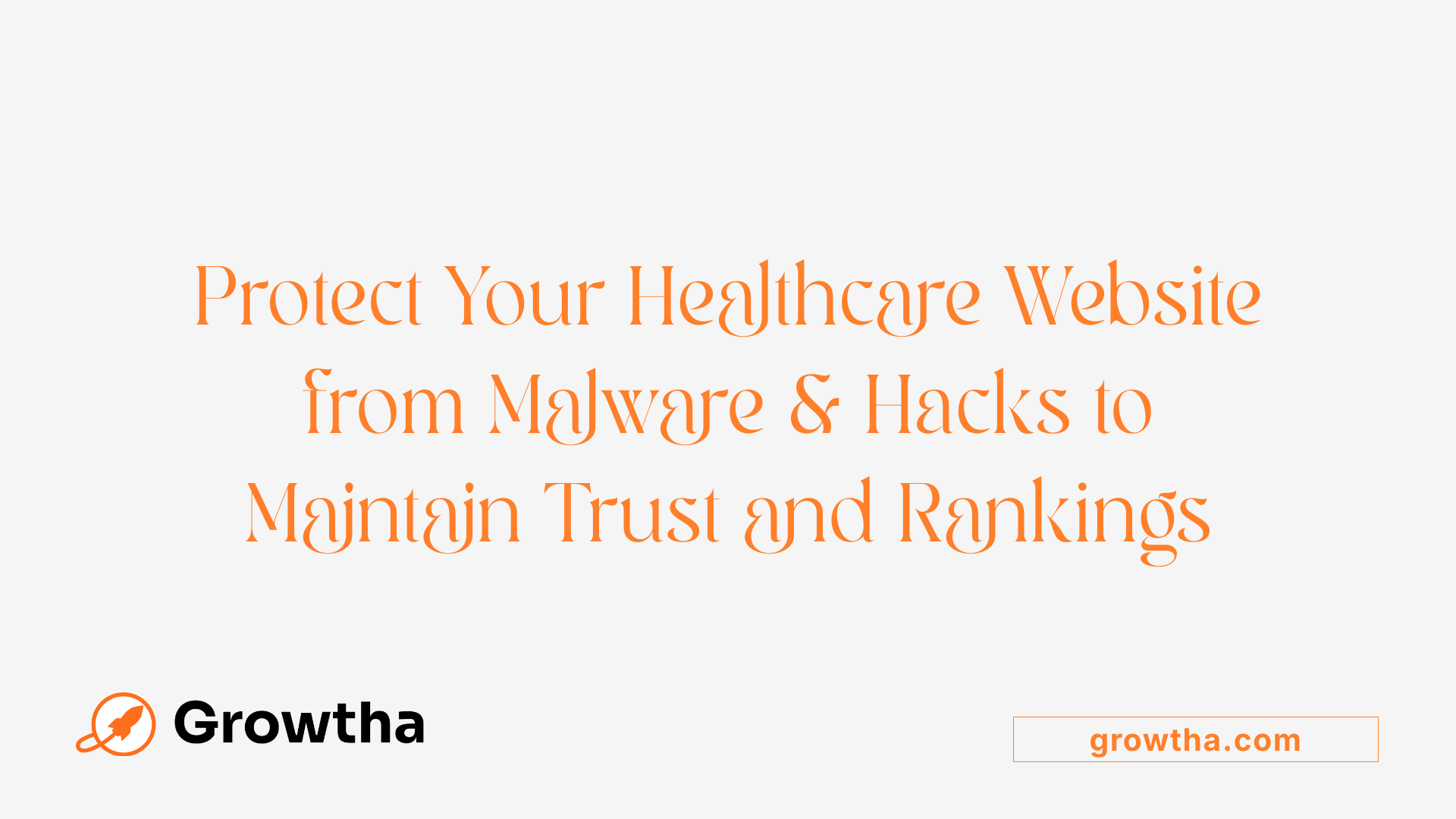Why Your Healthcare SEO Rankings Dropped
Understanding the Causes Behind Sudden Drops in Healthcare SEO Rankings


Why Your Healthcare SEO Rankings Dropped
Why Your Healthcare SEO Rankings May Be Falling and How to Address It
Healthcare providers rely heavily on search engine visibility to attract new patients and establish authority. A sudden drop in SEO rankings can significantly impact web traffic, patient inquiries, and overall online reputation. This comprehensive guide explores the common causes of such drops, how search engine algorithm updates influence rankings, and actionable strategies to diagnose and recover from ranking declines. By understanding these factors, healthcare providers can maintain a strong online presence, stay compliant with industry standards, and adapt to the ever-evolving SEO landscape.
Technical SEO Issues Contributing to Ranking Declines

What are common reasons for drops in healthcare SEO rankings?
Healthcare SEO rankings can decline due to several technical SEO issues. Common causes include slow website loading speeds, which can hinder user experience and fail Google’s Core Web Vitals tests. Crawling and indexing errors often prevent Google from properly recognizing and ranking pages. Broken links and incorrect redirects can lead to content being inaccessible or lost in the search results.
Misconfigured robots.txt files can block search engine bots from crawling vital pages, reducing overall visibility. Additionally, canonicalization errors—such as multiple URLs leading to duplicate content—may confuse search engines and dilute SEO authority.
Site hacking and malware infections are serious threats, compromising website integrity and trustworthiness. Such issues often cause Google to flag or remove affected pages or even blacklist entire sites.
Understanding these common issues is crucial for maintaining a thriving healthcare website. Regular technical audits and prompt resolution of errors help safeguard rankings.
Sidebar:
| Issue | Impact | Example |
|---|---|---|
| Slow loading speed | Low user engagement, ranking drop | Pages taking >3 seconds to load |
| Crawling errors | Missed indexing, lost visibility | 404 errors on core pages |
| Broken links & redirects | Decreased trust, missed traffic | Outdated or dead URLs |
| Robots.txt issues | Search engine blocklisting | Disallowed important pages |
| Canonical errors | Duplicate content, split authority | Multiple URLs for same page |
| Malware & hacking | Site security risks, blacklisting | Unauthorized code injection |
How do search engine algorithm updates impact healthcare SEO rankings?
Algorithm updates can significantly influence healthcare rankings, especially for YMYL (Your Money Your Life) content. Major updates like the Google Medic Update focus on the E-A-T (Expertise, Authority, Trustworthiness) principles, raising the bar for healthcare sites.
Such updates often cause fluctuations, with some sites experiencing dramatic drops if they lack verified medical expertise or have outdated content. Spam and low-quality content are penalized more aggressively, encouraging websites to adhere to strict quality standards.
Updates like the spam update target unnatural backlinks and keyword stuffing, which can affect healthcare sites employing aggressive SEO tactics. Moreover, the proliferation of AI content and featured snippets can change organic visibility patterns.
To navigate these changes, healthcare providers should prioritize authoritative, well-structured content, and stay informed about Google’s quality guidelines and core update schedules.
Sidebar:
| Update Type | Effect | Action Needed |
|---|---|---|
| Core Update | Fluctuations in rankings | Review content quality and E-A-T signals |
| Spam Update | Penalties on spammy backlinks | Disavow poor links, clean backlink profile |
| Medic Update | Focus on health-related content | Enhance trust signals, verify author credentials |
How can healthcare providers diagnose and troubleshoot SEO ranking drops?
Diagnosing ranking drops begins with tools like Google Search Console, SEMrush, or Ahrefs. These platforms help identify whether the decline is widespread or limited to specific keywords or pages.
Start by checking for technical issues such as server outages, crawlability problems, or misconfigured redirects. Tools like Google PageSpeed Insights and site audit reports reveal speed and accessibility issues.
Review recent site changes, including content updates, URL structure modifications, or new redirects. Content-related problems—duplicate content or outdated information—should also be scrutinized.
Backlink profiles can be examined to detect lost authoritative links or the emergence of toxic or spammy backlinks. Disavowing harmful links and building new, high-quality backlinks are essential recovery steps.
Finally, monitor manual actions or penalties within Google Search Console, and keep an eye on competitors' SEO strategies to identify external influences. A thorough, multi-faceted analysis enables targeted troubleshooting.
Sidebar:
| Step | Focus Area | Tool |
|---|---|---|
| Check technical health | Load speed, crawl errors | Google Search Console, PageSpeed Insights |
| Review content | Quality, relevance | SEMrush, Ahrefs |
| Analyze backlinks | Loss or spam | Ahrefs, SEMrush |
| Monitor penalties | Manual actions | Google Search Console |
| Competitor analysis | Ranking movements | SEMrush, SpyFu |
What strategies can healthcare websites use to recover lost SEO rankings?
Recovery involves a comprehensive approach. First, conduct a thorough technical SEO audit to identify and fix issues like slow site speed, mobile responsiveness, and crawl errors.
Next, enhance content quality by updating existing pages with accurate, authoritative information. Follow Google’s EAT principles, featuring verified medical expertise and credible sources.
Rebuild your backlink profile by reaching out for reputable backlinks from authoritative healthcare sites, directories, and local business profiles. Disavow toxic backlinks to prevent algorithmic penalties.
Optimize locally by maintaining a strong presence on Google My Business, collecting positive reviews, and targeting location-specific keywords and schema markup.
Stay abreast of recent algorithm updates and adapt your strategies accordingly. Consistently monitor your SEO performance, making incremental improvements based on data insights.
Sidebar:
| Action | Focus | Result |
|---|---|---|
| Technical audit | Speed, mobile, crawlability | Fixes to improve indexability |
| Content refresh | Accuracy, trust signals | Better relevance and rankings |
| Backlink development | Authority, trust | Increased domain authority |
| Local SEO | GMB, local keywords | Enhanced regional visibility |
| Monitor & adapt | Algorithm updates | Sustained ranking improvements |
What external factors influence healthcare search rankings?
External factors extend beyond website control. Industry competition plays a major role; competitors' SEO strategies and backlink profiles can push your site down.
Regulatory changes, such as HIPAA and data privacy laws, influence content strategies and site security, indirectly affecting rankings.
User behavior and search trends also impact rankings, especially if users shift their focus or preferences change.
Search engine updates and algorithm modifications, especially those targeting spam and low-quality content, can cause sudden ranking fluctuations.
Local relevance factors—like reviews, citations, and Google My Business profiles—are especially crucial in healthcare, where community trust and visibility matter.
Staying aware of these external influences and adjusting your SEO efforts accordingly helps maintain stable rankings.
Sidebar:
| Factor | Effect | Action |
|---|---|---|
| Competition | Displacement in rankings | Improve content & backlinks |
| Regulatory updates | Content & security standards | Ensure compliance |
| Search trends | Relevance & user intent | Update keyword strategy |
| Google updates | Algorithm shifts | Regular SEO review |
| Local factors | Proximity & reputation | Optimize local listings |
What content and website health factors are related to SEO ranking drops in healthcare?
Poor content quality, such as outdated or duplicate information, diminishes site authority and trust. Low-quality content can lead to lower rankings or penalties.
Technical issues like slow load times, mobile unfriendliness, broken links, and improper redirects harm user experience and crawl efficiency.
Loss of reputable backlinks weakens your site’s authority, reducing ranking potential.
Failure to follow E-A-T guidelines, including lack of author verification and untrustworthy sources, can lead to rankings declines.
Non-compliance with privacy regulations, like HIPAA, may trigger manual actions or trust issues.
Weak site architecture, poor internal linking, and minimal local SEO optimization reduce discoverability.
Maintaining site health requires routine audits, content updates, backlink profiling, and adherence to regulatory standards.
Sidebar:
| Issue | Effect | Improvement |
|---|---|---|
| Outdated content | Reduced relevance | Regular updates |
| Slow site speed | Poor user experience | Technical optimizations |
| Broken links | Crawl errors | Link management |
| Toxic backlinks | Trust reduction | Disavow and outreach |
| Non-compliance | Penalties or trust issues | Ensure HIPAA adherence |
How can healthcare providers analyze fluctuations in SEO rankings?
To analyze fluctuations, start with Google Search Console to pinpoint if changes are due to manual penalties, indexing problems, or algorithm updates.
Track keyword positions and organic traffic over time to identify patterns and pinpoint when drops began.
Use SEO tools like SEMrush or Ahrefs to compare backlink profiles, discover lost high-authority links, or detect spam links.
Examine recent site changes—content updates, migration, redesigns—that could influence rankings.
Monitor competitor movements to see if improvements or new strategies may be impacting your rankings.
Assess user engagement metrics such as bounce rate, dwell time, and conversion rates for signals of content relevance.
Combine these insights for a comprehensive picture, enabling targeted actions to stabilize and enhance rankings.
Sidebar:
| Tool | Focus | Benefit |
|---|---|---|
| Google Search Console | Penalties, indexing | Detects manual actions & errors |
| SEMrush / Ahrefs | Backlink & keyword | Find profile changes & opportunities |
| Analytics tools | User behavior | Correlate SEO with engagement |
| Competitor analysis | Performance comparison | Identify industry trends |
What are some best practices for maintaining and improving healthcare SEO?
Consistently produce high-quality, authoritative content that addresses patient needs and follows E-A-T principles.
Optimize on-page SEO: craft compelling titles, meta descriptions, and headers that target relevant keywords.
Ensure website technical health by improving load times, mobile responsiveness, and secure HTTPS protocols.
Implement structured data markup to enhance search listings with rich snippets.
Focus on local SEO by maintaining accurate Google My Business profiles and gaining positive reviews.
Engage in ethical link-building through partnerships with reputable healthcare sources.
Regularly audit site health, update outdated content, and ensure compliance with privacy laws like HIPAA.
Monitor performance metrics and adapt strategies based on data insights from Google Search Console and analytics platforms.
Staying informed about emerging SEO trends and Google algorithm updates is essential for long-term success.
Sidebar:
| Practice | Focus Area | Expected Outcome |
|---|---|---|
| Content quality | E-A-T, accuracy | Higher rankings and trust |
| Technical optimization | Speed, mobile, security | Better crawlability and user experience |
| Local SEO | GMB, reviews | Increased regional visibility |
| Link building | Authority signals | Authority and ranking boost |
| Continuous monitoring | Analytics & search console | Proactive issue resolution |
Maintaining a proactive and holistic approach to healthcare SEO ensures sustained visibility, trust, and engagement in a competitive online environment.
Maintaining and Enhancing Healthcare SEO in a Changing Digital Landscape
In conclusion, understanding why healthcare SEO rankings drop is vital for healthcare providers aiming to sustain a strong online presence. Whether caused by technical issues, algorithm updates, content problems, or external factors, each element plays a critical role in search performance. Regular technical audits, high-quality content creation, authoritative backlinks, and staying updated on Google’s guidelines are essential strategies to recover and improve rankings. As search engines continue to evolve, so must your SEO practices, ensuring compliance, relevance, and user trust. By proactively managing these factors, healthcare providers can enhance visibility, attract more patients, and uphold their reputation in an increasingly competitive digital environment.
References
- SEO Rankings Drop Guide: 10 Steps to Fix Common Issues
- 5 Reasons Your Healthcare Site Isn't Ranking In Search - Geonetric
- Google Ranking Dropped Dramatically? Here's What You Need to Do
- Why Your Google Rankings Dropped & How to Fix It - SEO.co
- Why Your Google Rankings Dropped and How to Bring Them Back
- Healthcare SEO: How to Improve Rankings + Costs Involved
- Shocking drop in rankings - Google Search Central Community
- Google Ranking Dropped Dramatically? How To Restore Positions
- 17 Common Reasons for Google Ranking Drops (Now With AI ...
- 9 Reasons Why Search Rankings Drop Quickly: How to Recover







